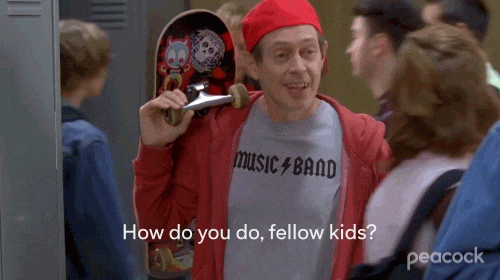There was a time — let’s call it 2013 for fun — when newsjacking felt like the pinnacle of real-time marketing. Brands raced to slide into trending headlines, holidays, or celebrity tweets with a clever twist and a well-timed post. Sometimes it was brilliant. Often, it was awkward. But at the time, it worked.
Anybody remember Oreo’s Dunk In The Dark moment or shoe brand Kenneth Cole’s #Fail with their #Cairo tweet? Or, maybe you remember the now six-year-old Aviation Gin moment where they trolled Peloton’s advertising?
The formula was wildly popular and painfully simple: Write a blog or social post titled, “What [insert major cultural phenomenon] Can Teach Us About [insert your industry buzzword].”
Let’s be honest — most of us cranked out at least one headline that fit the pattern:
“What Breaking Bad Teaches Us About Sales Enablement"
“Marketing Lessons From Justin Bieber’s Haircut"
“5 Lessons Content Marketers Can Learn From The Hunger Games"
(Yeah, that last one is real.)
It was the golden age of forced relevance, and we all had the template.
But today? Newsjacking feels almost ... quaint.
It’s not just that we’ve moved past the novelty of the “cookie brand tweets about the Super Bowl blackout” era. The bigger shift is that in 2025, most news cycles move too fast, cut too deep, or hit too close to home for brands to comfortably weigh in.
Today, hijacking the moment feels less like clever marketing and more like reputational roulette. The world is in a bit of a bad mood when it comes to the news, and, increasingly, brands don’t want to be part of the conversation.
However, as the “for you” algorithm invades every media surface — from search to social and even our owned media properties — there does seem to be something interesting happening. Companies have an opportunity to do more than just be part of the conversation: they can show they belong in it.
Enter the meme.
Memes aren’t just funny — they’re fluent
What started as niche in-jokes in the internet's earliest days are now fully integrated formats for brand storytelling — yes, even in B2B — where shared pain, complexity, and jargon are all fertile ground for insider humor. Memes don’t just ride the wave of culture. They compress, remix, and circulate it through the subcultures and communities where your buyers already live.
As we head into the back half of 2025, it feels like we’re in the midst of what I’d call a meme maturity moment. But this isn’t the same meme culture that originally played alongside newsjacking — where success was measured by virality. In 2025, the game has changed.
Memes are now so easy to create and so embedded in our daily scroll that they’ve evolved into something closer to modern emojis — not just formats, but content types. Distinct communication vehicles. Tools for signaling niche understanding, emotion, and identity in a flash.
The point of using memes in marketing isn’t to go viral anymore. It’s to go relevant. The best B2B memes don’t land just because they’re funny — they land because they feel true. They communicate with community members like an insider would, and that’s what makes them work.
Additionally, it’s not just the humor that creates the marketing value. Memes have become the punchline that proves you understand the setup, that you are self-aware, and that you can speak the language of the community in which you’re trying to resonate.
“Thought leadership” might be tired
According to research firm Kantar, humor in advertising and marketing has steadily been disappearing over the last two decades — a trend that only accelerated during the pandemic. But it’s not because the world has gotten more serious. What’s changed is marketers’ growing hesitation to use humor at all, largely driven by the fear of getting it wrong.
Meanwhile, Edelman and LinkedIn’s annual B2B Thought Leadership Impact Report notes that B2B decision-makers increasingly value content that is not only authoritative but also genuine and relatable.
In a content ecosystem bloated with AI-generated summaries, “thought leadership” platitudes, and mid-tier video clips, the meme has emerged as one of the few formats that still requires human context.
To gut-check my thinking, I reached out to one of the smartest content marketers (and easily one of the funniest humans) I know: my friend Tim Washer. Tim has an uncanny understanding of what makes people laugh, especially in the often too-serious world of B2B.
When I asked if he was seeing a similar shift toward meme-driven content, he put it perfectly:
“B2B thought leadership is usually neither. The creators who build a sense of connection with their audiences will gain affinity with customers. Laughter reigns supreme as the most efficient and effective way to build rapport and earn trust. A super simple way to do this is to include a relevant meme, especially if it speaks to the pain point our B2B customers are facing in the moment.”
Memes can be both strategic and silly
AI is putting real pressure on marketers to create good content that stands out from the daily avalanche of material flooding the internet.
However, AI is sanding down the web as it becomes more prevalent, especially in B2B marketing contexts.
Product pages have started to look like they were all built in the same CMS, using the same UX checklist. Social content — from scrappy B2B startups and massive enterprises — often feels generated from the same overly sanitized, beat poetry-style prompt. And thought leadership? Half the time, it reads like it was assembled by a polite intern named PromptBot, determined to “make synergy happen.”
There’s an ongoing (and oddly passionate) debate over how to spot AI-written content. Is it the em dash? The word “delve”? The overuse of “coherence”? Or maybe it’s when three consecutive paragraphs begin with, “Here’s the hard truth …”
Well, here’s the hard truth: Honestly, it doesn’t matter, because the fact that we’re even having the debate is the point.
Whether it’s AI training the human, or the human trying to sound like AI, audiences are feeling something — and it’s not resonance. It’s the ick. That subtle, skin-crawling sense that what they’re reading wasn’t made for them, it was just made to fill space.
In that sea of sameness, memes don’t just stand out because they’re funny. They stand out because they require understanding.
A meme only works if you get the joke, and getting the joke proves you’ve been in the room. You’ve sat through the terrible marketing standup. You’ve fought the CRM. You’ve whispered, “We’re not ready for this webinar” under your breath 10 minutes before going live.
Memes are compressed context. And in B2B, context is everything.
In modern B2B marketing, trust is built at the edges — not through messaging pyramids or multi-channel customer journey maps, but through those tiny, high-context signals that whisper, “We know what solving this challenge is really like.”
Peter Drucker once said, “The most important thing in communication is hearing what isn’t said.” A good meme is exactly that. It’s not just what it shows — it’s what it reveals.
The 5 Ps of B2B meme success
Here’s a practical way to evaluate whether a meme belongs in your brand’s voice — and how to deploy it without losing trust or relevance.
1. Take the pulse: Track what’s happening before it peaks.
Meme culture moves fast. B2B culture moves more slowly, but it still moves. Make sure that it’s a classic, or that you’re moving quickly enough to remain relevant in whatever time frame you’re referencing.

Your brand showing up two weeks late.
2. Do you have permission? Not all brands can go there. And that’s OK.
Your brand voice defines where and how humor shows up. Can you make fun of your buyer’s pain? Can you joke about your own product? If you’re selling compliance software to federal agencies, maybe stay out of SpongeBob's square pants. But if you’re selling dev tools or sales enablement? Your audience wants to know that you get the absurdity.
Ask: “Do we have the trust — or tone — for this joke to land?”

When your enterprise compliance software account tries to post a SpongeBob meme.
3. Make sure you keep perspective: Don’t just reuse — add insight.
The best B2B memes don’t just repeat the trends; they remix them. You’re not borrowing a format to be relevant. You’re using it to say something specific about your category, customer, or worldview.
Ask: “What truth are we surfacing — and is it ours to tell?”

4. Watch Your Placement: Choose the right channel for the right moment.
Memes in a Slack community? Gold. Memes on your sales team’s LinkedIn? Maybe. Memes in a keynote deck for your board? Hmm, maybe not so much.

As you would in any good content strategy, map your meme to the medium. Even within LinkedIn, the same meme may hit differently from a founder, a community manager, or the brand account.
Ask: “Where will this meme not just survive, but thrive?”
5. Create the Playbook: Create rules, not red tape.
Empower creators with principles, not approvals. Define meme-safe zones. Flag no-go formats (e.g., tragedy-jacking, edgy, Twitter-style sarcasm). Build in optional legal review lanes — but don’t build a bureaucracy.
Ask: “Have we enabled creative freedom with clear boundaries?”

When you let the intern post memes without brand guidelines.
The meme is the medium
For a long time, memes in B2B were treated like emojis in a corporate email: playful, but unprofessional. Optional. Peripheral. Something you might get away with if you were a scrappy startup or had a cheeky social team.
That era’s over.
Memes aren’t filler between real content — they’re fast-moving containers for meaning. When used well, they prove that your brand doesn’t just serve a market — it understands it. That’s not noise, it’s a signal. And in modern B2B, signal is everything.
Yes, AI can generate copy. It can write a blog post. It might even summarize your case study. But it can’t feel the shift in a sales team’s mood during Q3 forecasting. It can’t read the room at a security conference. And it can’t make your audience laugh because they feel seen.
Memes are what’s left when content gets compressed and culture gets specific.
They’re not just funny. They’re fluent.
If you’re serious about relevance, resonance, and trust, don’t wait for permission. Start speaking in a language your buyers already use. You’re not just joining the conversation. You’re proving you belong in it.
It’s your story. Use a meme or two — and tell it well.
Subscribe to workday or weekly CMI emails to get Rose-Colored Glasses in your inbox each week.
HANDPICKED RELATED CONTENT:



